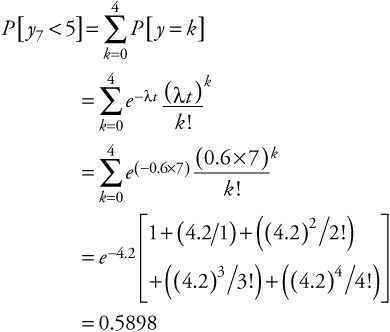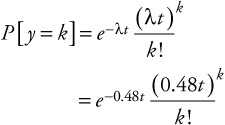6.3 Poisson process
|
| < Free Open Study > |
|
6.3 Poisson process
An important stochastic process used in computer systems performance evaluation is the Poisson process. A Poisson stochastic process has the property that events are independent, and the interarrival times of events can be described using the exponential distribution F(t) = 1 - e-λt. For example, the events described could be the arrival of a transaction for service, the completion of transaction processing, or the service time for the transaction. Given that the mean time between some event is 1/λ, the rate of occurrence of the events will be λ. The Poisson process possesses the following properties:
-
Occurrences of events during nonoverlapping intervals of time are independent.
-
For small increments of time the probability of zero events is 1 - λ∆t, and the probability of an event occurring during the same time is λ∆t.
Poisson stochastic processes have many desirable properties. If two Poisson arrival streams are merged, the resultant stream is also a Poisson stream with the rate equal to the sum of the input rates. Consider, for example, Figure 6.5 with {N1 (t),t ≥ 0} and Rate λ1, {N2(t),t ≥ 0} and Rate λ2, the resultant stream, {Nsum(t), t ≥ 0}, has Rate λ1 + λ2.

Figure 6.5: Two Poisson arrival streams merging.
If a Poisson stream is divided into two streams, with each event going to stream A with probability PA and stream B with probability PB, the resulting streams are Poisson with rates PAλ and PBλ. (See Figure 6.6.)

Figure 6.6: Poisson stream dividing.
Let's look at an example using some of the basic properties of the Poisson process and some of the fundamental concepts from probability. In this example, a computer center has a large number of separate system components that may fail-for example, terminals, tape drives, disks, printers, sensors, CPUs, and so on. When these items fail, they do not bring the entire computer system down. We know that for this system there are on the average 0.6 failures per day. Failures are independent. These failures can be represented by a Poisson process with rate λ = 0.6 (per day). In addition, the time between failures is observed to be exponentially distributed. What is the mean time between failures?
| (6.9) |  |
Using the initial conditions, we can see that the number of failures in an interval of t days has the Poisson distribution with a mean of 0.6t. We can use this to determine the number of failures we could expect during any specific period of time. For example, we could ask what the probability is of exactly one failure in a 24-hour period.
| (6.10) |  |
Or we could ask what the probability is of less than five failures in a week.
| (6.11) |  |
This implies that we have a 0.5898 probability of getting less than five failures within this period of time.
Conversely, we could start from a random point in time and determine what the probability is that no failure will occur during the next 24 hours.
| (6.12) |
Using the fundamental properties of the Poisson process we could postulate other questions as we discover or measure our system. For example, suppose exactly 24 hours has elapsed with no failures. What is the expected time until the next failure? The Poisson process supports the memoryless property-that is, past history does not aid in predicting future history (independent increments). The result of this question is the same as the initial question, which asked what the probability is of the next failure.
| (6.13) |  |
As another example, we know that four out of every five failures is a terminal problem, where each of these failures occurs with equal probability on each failure (see Figure 6.7). We may wish to determine what the process describing the terminal failure is. One must first recognize that this can be modeled as a Poisson process, where the total stream (representing failures) can be broken into a split stream, both of which also are Poisson processes. Given this assumption, we can state that this is a Poisson process with rate PAλ = (4/5) 0.6 = 0.48/day for the terminal failures.

Figure 6.7: Possibility of a terminal failure.
The average time between terminal failures is 2.083 days.
We can also determine the number of terminal failures in t days given by:
| (6.14) |  |
|
| < Free Open Study > |
|
EAN: 2147483647
Pages: 136
- Static PE-CE Routing Overview, Configuration, and Verification
- Case Study-Inter-AS Implementing Route-Reflector and BGP Confederation in Provider Networks
- Implementing VPNs with Layer 2 Tunneling Protocol Version 3
- Configuring L2TPv3 Tunnels for Layer 2 VPN
- Case Study 1: Implementing Multicast Support for MPLS VPNs